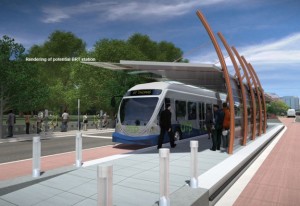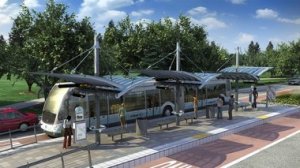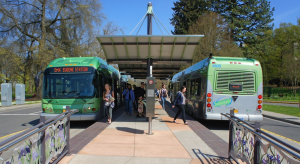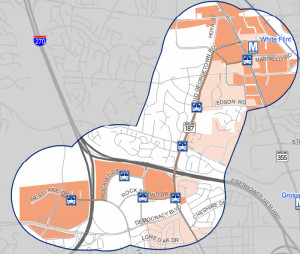The Mission of the National BRT Institute is to facilitate the sharing of knowledge and innovation for increasing speed, efficiency, and reliability of high-capacity bus service through the implementation of BRT systems in the United States.
Bus Rapid Transit Series: The Basics
Bus Rapid Transit is coming to Omaha! This isn’t news for most of you, by any means, but things have been quiet on the BRT front lately so a little reminder never hurts.
Bus Rapid Transit (BRT) can take a variety of forms as there are many factors that impact the quality of a BRT system. Fortunately, the Institute for Transportation & Development Policy has a handy scorecard that can be used to gauge the quality of the system Metro is planning.
In the coming weeks, we’re going to start highlighting and discussing the different aspects of a BRT system in Omaha. Here are just a few of the many BRT components that we’ll dig into:
- Dedicated right-of-way
- Station quality
- Hours of operation
- Frequency of service
- Bike friendliness
- Signal prioritization
- Branding
- Passenger information
Before we go there, however, here are the basics with respect to Omaha’s BRT. (For more information…
View original post 276 more words
Bus Rapid Transit Series: Stations & Stops
An extremely important element of a Bus Rapid Transit (BRT) system is the quality of the stations and stops. A good station can attract new riders, provide shelter from the weather, promote visibility and facilitate branding of the system, provide information, ensure safe accessibility to the BRT, and much more.
These stations and stops can take many forms. At their worst, they resemble the bus stop that characteristic of Metro’s system today, which primarily consists of a sign on a pole…occasionally there’s a bench, and every once in a while you can find shelter from the weather. At their best they can resemble large rail terminals.
The American Public Transportation Association’s Recommended Practices for BRT Stations and Stops puts them into four categories:
- basic stops
- enhanced stops
- stations
- transit centers
Basic stops are hopefully not an alternative not being considered for Omaha’s BRT – it’s basically what we have now…
View original post 602 more words
JULY 2015 RTS (BRT) Cost Estimate
The July BRT cost estimates were made for four corridors: The MD 355 North corridor that would run from Clarksburg to the Rockville Metro station, the MD 355 South corridor that would run from the Rockville Metro station to the Bethesda Metro station, the US 29 corridor that would run from Burtonsville to downtown Silver Spring and the Veirs Mill Road corridor.
Remarkably, the county is giving priority to a BRT line running along the path of the existing Red Line when the North Bethesda Transitway, which has been in the Master Plan for more than 20 years, remains unbuilt. Building the North Bethesda Transitway is an essential step to revitalizing the Rock Spring area, which the county considers a priority.
Gables Pike District
A three-building, 476-unit mixed-use project on five acres between Old Georgetown Road and a realigned Executive Boulevard. Realignment of Executive Boulevard will create a rectangular block on which to build the project. The existing Executive Boulevard runs diagonally through the center of the site.
Montgomery County Office Market Assessment
The June 18, 2015 Montgomery County Office Market Assessment does not paint a pretty picture for Rock Spring, but this finding points the way to an answer:
The most successful office clusters in Montgomery County are part of mixed-use developments with a strong sense of place and a quality environment. Transit connectivity is increasingly important to office tenants. This trend is consistent with recommended land use strategies in recent County plans for White Flint, Bethesda, White Oak and other communities.
Early completion of the long delayed North Bethesda Transitway is the key to reinvigorating Rock Spring.
BRT Guide
The Maryland Department of Transportation (MDOT) produced a guide to provide local jurisdictions, transit operators and other stakeholders an outline of how to make careful and informed decisions about BRT.
North Bethesda Transitway Options
On November 8, 2013, the Transportation, Infrastructure, Energy and Environment (T&E) Committee recommended (3-0) to retain two alternative routes for the North Bethesda Transitway east of the Tuckerman Lane intersection, one of which would be implemented after further analysis in a facility planning study:
- The route to the White Flint Metro Station recommended in the Final Draft, with stations both at Edson Lane and Executive Boulevard, with the proposed minimum right-of-way, in dedicated lanes north to Executive Boulevard with up to 1 added lane to the cross-section for transit, and in mixed traffic east to the Metro station; and
- East on Tuckerman Lane to the Grosvenor Station in existing master-planned right-of-way, no intervening stations, in dedicated lanes but no added lanes to the cross-section fortransit.
Montgomery Row
Montgomery Row is a 168 townhome project by EYA that includes space designated for the future bus rapid transit station (North Bethesda Transitway) that would connect Westfield Montgomery mall with the White Flint Metro station.
The Pike District
The Pike District is the northeastern terminus of the North Bethesda Transitway. A new community extending from Grosvenor-Strathmore metro station to Twinbrook metro station. The Pike District offers retail, dining, housing, employment, and entertainment options – all within a short walk of the Pike District’s three Metro stations: Grosvenor, White Flint and Twinbrook.




